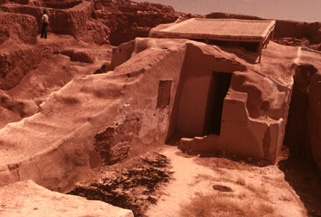Gardner on Steven Mithen’s The Prehistory of the Mind
[ Howard Gardner “Thinking about Thinking,” NYRB, Oct. 9, 1997, pages 23- 27.]
religion, art, and science arise in a prehistoric “mentality” of a tool maker culture

symbolic and mimetic capacities inherent in language, speech & dexterity is traced to a two-million year long movement in three stages:
1. use of bodies to imitate older and more sophisticated members of the group.
2. spoken language to tell stories.
3. invention of symbolic and notational systems used eventually to preserve memories and transmit complex forms of culture such as religion, art, and knowledge. [23]
Archaeological remains of the Library in Ebla, Syria.
“I find most convincing Mithen’s claim that human intelligence lies in the capacity to make connections: through using metaphors..., or through the unexpected juxtaposition of images that make us laugh.”
[ Gardner, page 25.]
“To make connections is to link the various quasi-independent intellectual modules.”
![]()
Gardner posits 8 intelligence's { intellectual modules? } modes of impression & expression
![]()
Gardner’s Multiple “Intelligences” 7 liberal arts
1. logical / mathematical numerical - symbolical arithmetic
dialectic
2. verbal / linguistic grammatical - syntactical grammar
3. visual / spatial design, dimensions, angles geometry
4. bodily / kinesthetic coordination, fine manipulation
5. musical / rhythmic musical composition or practice music
6. social / interpersonal empathic -- emotive rhetoric
7. solidarity / self awareness emotional well being, self imagery
8. naturalistic / nature study ability to interpret indications in nature astronomy
![]()
Jerry Fodor’s description of different “modules of the mind” (... based on Noam Chomsky’s theory ...- the mind not one but many separate ‘thinking’ devices, each with a separate purpose.) [24]
general intelligence is a vague and insubstantial term consisting of [25-26] specific
- sensory 6 senses [touching, smelling, tasting, hearing, seeing, immunity]
- perceptual mental interpretation of what one “apprehends”
- conceptual verbal, visual, or written expression of what one “comprehends”
- emotional skills the affective dimension of how one accepts or rejects life
Karmiloff-Smith’s research in support of Piaget’s generalized developmental stages:
- infancy (earliest months)
- 1. recognition of adult sounds,
- 2. musical tonality (differences in consonant and dissonant intervals),
- 3. recognition of facial patterns,
- 4. responsiveness to engage in highly specific communicative exchanges with loving caregivers,
- 5. appreciate simple numerical operations,
- 6. imitate actions of others,
- 7. awareness of their own bodies.
evidence shows that infants are aware of basic properties of objects a full year before Piaget thought they were [26]
"recent research on early infancy provides the strongest clues to the inherent modularity of human cognition.”
“they are constructed so that they automatically become active under appropriate circumstances.” [26]
? “how the various modules become able to work together.” [26]
for example we harbor capacities [probably genotypic and phenotypic] to:
call express needs
perceive sensory signals
compare distinguish among competing stimuli
associate group sensory impressions
infer imply meanings (see what is not often obvious, or there!)
“Empirical evidence shows that the mind -- human or prehuman -- is distinguished precisely by the fact that it does not treat all experiences or all problems as equal and does not harbor all purpose rules or operations.”
“highly particular nature of these species -- intelligence” Culture transmits “intelligence.”
sparrow’s song, maze-running rodents, dance in bees, foraging by ants, whale’s songs
time is ripe to integrate findings from:
evolutionary psychology, developmental psychology, brain study, and cognitive archeology.
Two great prehistoric achievements:
1. numbers of specific unconnected “mental” capacities -- like chambers in a building
2. enlarged capacities with better interconnected capacities -- like big rooms & ante-chambers “new meta-chambers (for such ‘modern’ functions as consciousness).” [27]
Since 1996, these discoveries have altered what we know about the evolution of the mind:
• hominids with stone tools existed 400,000 years earlier than previously thought
• Homo erectus still lived as recently as 27,000 years ago!
• finely crafted spears are 400,000 years old
• dogs may have been domesticated 135,000 years ago
• Neanderthals may have composed music for the flute [25]
 |
|||||
 |
|||||
 |
|||||
